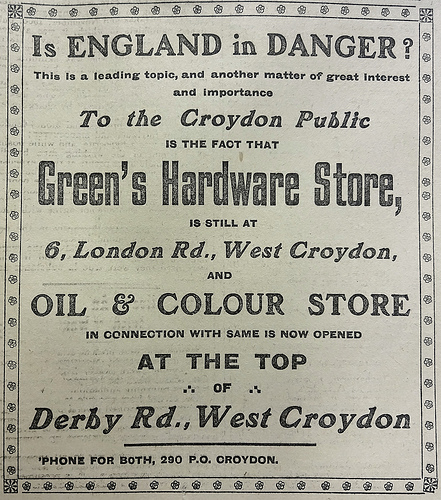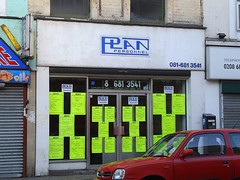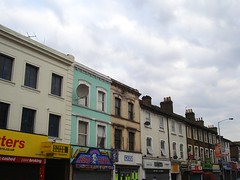A-Z Pharmacy at 20 London Road is both one of the oldest buildings on this part of the road and one of the longest-standing businesses. The building has been in use as a pharmacy since the mid-1980s, with the current owner in charge since the turn of the century.
1850s–1860s: Henry Anscombe
The first occupant was Henry Anscombe, who appears in Croydon street directories from 1855 to 1869. The 1861 census lists his home as 2 Railway Cottages, and the 1868 Town Plans show it as part of a small block of buildings adjacent to the station entrance.[1]
The 1861 census also includes Mr Anscombe’s wife Eleanor and five children, as well as his widowed sister, Jane Austin. Mrs Austin was a monthly nurse, probably staying with her brother in a break between live-in nursing jobs.[2] Henry Anscombe himself was the superintendent of railway police at London Bridge Station.[3] The Anscombe family remained at 20 London Road until around the end of the 1860s, before moving to St Thomas’s Street in Southwark.[4]
1870s–1890s: Samuel Piggott, ironmonger
The next inhabitant might have been an upholsterer named J E Hastings, but I don’t have enough evidence to decide whether said upholsterer was here or next door at number 22.[5] In either case, J E Hastings’ tenure on London Road was very brief; Ward’s 1874 directory lists a gas-fitter and ironmonger named Piggott at the modern number 20 and a greengrocer, fishmonger, and poulterer named J Dossett at the modern number 22.[6]
Samuel Piggott remained at 20 London Road until the early 1890s, with street directories during this time listing him variously as a “gas-fitter and ironmonger”, “furnishing ironmonger”, and “ironmonger and oilman”. Around 1892 he was replaced by Joseph Linden Green, also a furnishing ironmonger.[7]

1890s–1920s: Joseph Linden Green, Green’s Hardware Store
From 1904 to 1924, street directories list the property as Green’s Hardware Store. I don’t know the significance of the change to this name from the simple “Joseph Linden Green”. I did wonder if it marked Joseph’s bringing his oldest child into the business, but according to census data, Joseph and his wife Laura had only been married since around 1891, so wouldn’t have had an adult child in 1904.[8]
My next theory was that the name change might have coincided with Joseph’s business doing well enough that he decided to use the entirety of the London Road property for business purposes and move his domestic situation elsewhere, but according to Ward’s street directories he’d already been living on Wellington Road since around 1897.[9] In any case, it seems clear that the Green of Green’s Hardware store was our Joseph Linden Green.
The last appearance of Green’s Hardware Store is in Ward’s 1924 directory; the 1925 edition lists the property as “unoccupied”. Joseph Green would have been around 60 at this point, so may well simply have decided to retire.[10]
1920s: Betty, milliner and costumier
The next occupant of the property came via a slow move sideways from number 22 next door. Betty, milliner and costumier, began operating from 22 London Road in 1922. Around 1926, she expanded her business to number 20 as well, and around 1929 she gave up number 22 and settled in number 20 alone.[11] “Settled” is perhaps the wrong word here, though, since by early 1931 she had vacated London Road entirely.[12]
1930s: Greens, ladies’ outfitters
Betty was replaced by Greens, ladies’ outfitters. Greens’ sojourn at 20 London Road was brief,[13] but an idea of its business can be gleaned from a small advertisement for staff, placed in the 1 October 1932 issue of the Croydon Advertiser: “COATS AND GOWNS.---First Sales, able to take charge, dress windows, etc; also experienced Sales ladies; medium class trade.---Apply between 3 and 5 Wednesday, 20, London Rd, Croydon.”[14]
1930s–1940s: Dawsons, ladies’ outfitters
By early 1933, Greens had been replaced by another ladies’ outfitters known as Dawsons, which remained at the premises until at least the early 1940s.[15]
1950s: M Richman, furniture dealer and bookseller
There is a gap in the record here, as the next documentary evidence is of M Richman, furniture dealer and bookseller, listed in Kent’s 1955 and 1956 directories.
1950s–1960s: Etam
From the late 1950s to the mid-1960s, 20 London Road was a branch of Etam, a ladieswear shop with other branches nationwide. Its first Croydon branch was at 34 North End, which today is occupied by WHSmith.[16] The London Road branch opened in 1957 or early 1958 and had closed by August 1965, though the North End one remained open.[17]
1960s–1970s: Diamond Records
The next occupant was Diamond Records, in place by August 1965.[18] Journalist Mick Brown recalls a Saturday job there a year or so later, “selling Wilson Pickett and Sam & Dave records to mods”. Mick adds: “The shop used to be rammed on a Saturday - mods who had heard records at the Orchid and Top Rank Suite and the Orchid, Purley coming in to buy them; and West Indians coming in for the new Blue Beat records. It was like a party.”[19]
On 22 May 1981, an Extraordinary General Meeting of “Pendeve Limited (Trading as Diamond Records)” was held at 20 London Road, and passed a resolution stating “that the Company cannot by reason of its liabilities continue its business, and that it is advisable to wind up the same”.[20] Two days later, a planning application was submitted to change the use of 20 London Road from a shop to a “specialist Employment Bureau for catering trades”. (Permission was granted, but a note attached to the application states that this permission was not taken up.)[21]
1980s-1990s: Goulds chemists
By November 1982, the property was occupied by a household goods shop called Bargain Finders,[22] and by April 1986, Bargain Finders had become Goulds chemists, which remained on London Road for a good 15 years.[23] Goulds was prominent enough to appear in a 1995 feature in the Croydon Advertiser, focusing on London Road. Its entry there states that as well as the usual chemists’ products it stocked “a wide range of Afro hair products” and provided services such as ear piercing, film processing, and pregnancy testing. It also had “an up-to-date computer system storing patient medication records”.[24]
2001–present: A-Z Pharmacy
A-Z Pharmacy opened on 1 June 2001, and is still there today. Owner Mr Sotubo tells me that he chose the name for its connotations of covering everything that a customer could possibly need.[25] His ambition seems to have been realised, since I for one use it frequently. The staff are helpful and friendly, and a private consulting room is available for confidential consultations. Open seven days a week, it dispenses prescriptions and provides sexual health and “stop smoking” services, as well as selling various useful items from baby teethers to denture tablets.[26]
Thanks to: Mr Sotubo and the staff at A-Z Pharmacy; Mick Brown; Brian Gittings; John Clarke; Colin Withey; the Planning Technical Support Team at Croydon Council; all at the Croydon Local Studies Library; and my beta-readers bob and Steve.
Footnotes and references
- See my article on 18 London Road for evidence that 1–2 Railway Cottages later became 18–20 London Road, and that these are the buildings shown on the 1868 Town Plans.
- Jane Austin’s profession is given as “nurse [indecipherable squiggle]” in the 1861 census. She’s also listed as a monthly nurse at Henry Anscombe’s home in Gray and Warren’s 1861–2 street directory. By the time of the next census in 1871, her profession is still “monthly nurse” and she’s living with the Odell family on Holmesdale Road; it seems clear that these are employers rather than more relatives, as her relationship to the head of the household is given as “servant”.
- West Croydon Station is listed in Warren’s 1861–2 directory as “Croydon Railway Terminus”. The same directory describes Henry Anscombe as “Superintendent at the London Terminus” a few lines later; it seems quite clear that these must be two different stations. West Croydon Station opened in 1839 as the terminus of a line from London Bridge. The “London Terminus” is thus almost certainly London Bridge Station. The Anscombes’ move to Southwark around the end of the 1860s is also suggestive along these lines.
- The 1871 census lists Henry, Eleanor, and four of their children at 9 St Thomas’s Street in the Parish of Saint Thomas, Parliamentary Borough of Southwark. His profession is given as “Supt L B & S C Rlwy” — “Supt” is obviously short for “superintendent”, and “L B & S C Rlwy” would be the London, Brighton, and South Coast Railway.
- The east side of London Road had no street numbers until 1890. Wilkins’ 1872–3 street directory lists the buildings on this side of the road from the station going north as Mrs Kingsland (who as I’ve shown previously was at number 18), J E Hastings, and an ironmonger named Newton. Ward’s 1874 directory lists Thomas G Newton, general furnishing ironmonger, at 1 Oakfield Terrace, which was renumbered in 1890 to 10 London Road and again in 1927 to the modern numbering of 28 London Road, so J E Hastings must have been at number 20, 22, or 24–26 (note that 24–26 is not a double shopfront despite the double number). The 1894–5 Town Plans show that number 24–26 didn’t exist at that point, so J E Hastings can only have been at number 20 or 22. I haven’t been able to narrow it down any more than this.
- As noted in the previous footnote, there were no street numbers on this side of the road until 1890, and the numbering changed again in 1927. As with all my statements of who was where prior to 1927, I worked out where Piggott and Dossett were in terms of modern numbers by following the occupants of the properties through the years until I get to the 1927 number.
- Information taken from Ward’s and Kelly’s street directories, consulted at Croydon Local Studies Library. J L Green, furnishing ironmonger, is listed up to and including Ward’s 1903. Green’s Hardware Store is listed from 1904.
- Joseph and his wife Laura have no children listed in the 1891 census, and their oldest child in the 1901 census is 8-year-old Florence. The 1911 census states that their marriage had lasted 20 complete years by that point.
- Joseph Linden Green appears in Ward’s directories’ listings of “Principal Residents” for the first time in 1897. His home address in this year is 1 Wellington Road, listed as being on the left side of Wellington Road going from 9 St James’s Road to Elmwood Road. The previous year’s directory lists this side of the road as being occupied by “gardens”, so Joseph would have been the first resident of 1 Wellington Road. The 1891 census lists him and his wife Laura on London Road (at number 6 in the numbering of the time, corresponding to modern number 20). So it seems likely that he moved his family from the shop premises to a newly-built home on Wellington Road around 1897.
- Joseph was 45 at the time of the 1911 census, so must have been born in 1865 or 1866, making him 59 or 60 in 1925. He certainly didn’t die in 1925, as he’s listed at his home address of 65 Kidderminster Road (where he moved around 1910) in Ward’s directories up to 1939 (which is when regular publication ceased).
- Evidence here is from Ward’s and Kelly’s street directories, though I’ve simplified a little. The street directory listings are a bit confusing, and the situation isn’t helped by the 1927 renumbering of London Road. Specifically, a business called Pioneer Teeth Institute Ltd is listed alongside Betty’s throughout the latter’s time on London Road, but with no accompanying number until it receives the number 22a in the 1927 renumbering. My best guess is that it was on the first floor of the property now numbered 22.
- “Betty, Milliner, Gown Specialist” is listed in London phone books up to and including September 1930, and is absent from the February 1931 edition. All phone books consulted via Ancestry.co.uk at the Croydon Local Studies Library.
- Greens, ladies’ outfitters, is listed in Ward’s 1932 street directory (and not the two on either side, from 1930 and 1934 respectively). I haven’t found it in the phone books, possibly because it’s a very common name and I gave up looking.
- Croydon Advertiser consulted on microfilm at the Croydon Local Studies Library. This small ad doesn’t give the name of the business, but from the timing it seems most likely to be Greens.
- Phone books from February 1933 to November 1940 inclusive list “Dawsons (Costumiers) Ltd” at 20 London Road.
- The numbering of North End is a little confusing. Dorothy Perkins/Burton and WHSmith both claim on their websites to be at 34 North End, and the Royal Mail postcode finder backs this up (well, it says the former is at 34–36). However, the Burton building was actually built by Burton (London Footprints says “Built in 1926 with Portland Stone and metal windows in Burton's house style” and the company logo is still visible on the frontage today), so it seems likely to have remained under the same ownership ever since. I can find no evidence of Etam having been connected with Burton in the 1950s, so I’d say Etam was at the 34 North End now occupied by WHSmith, rather than the one occupied by Burton.
- The October 1955 and January 1957 Kent/Surrey phone books list only one branch of Etam in Croydon, at 34 North End. From April 1958 to May 1964 inclusive, both the North End and the London Road branches are listed. From August 1965, only the North End branch remains.
- Diamond Records is listed at 20 London Road in the August 1965 North East Surrey phone book. Brian Gittings’ 1980 journal of Croydon retail lists both Diamond Records and “Martin Jones Assoc — loss adjusters” at the address (the latter being “F/O 20”, presumably “front of”); this is the only mention I’ve seen of Martin Jones.
- Information from Mick Brown provided via Twitter. See The British Record Shop Archive for more people’s memories of Diamond Records.
- This notice appears on page 7574 of the 3 June 1981 London Gazette.
- Planning application viewed on microfiche at Croydon Council offices (ref 81/20/709).
- The May 1981 North East Surrey phone book lists Diamond Records at 20 London Road, while the November 1982 edition lists Bargain Finders. Bargain Finders is listed as “ho/gds gen” in the March 1983 and March 1984 Goad plans. The London Shop Surveys 1984–85 lists “Hazelminster (H’hold)”; I don’t know if this was an alternative name for Bargain Finders. In my experience, it’s fairly common for uncertainty to exist over the naming of cheap household goods shops.
- Goulds is listed on the April 1986 Goad plan. I should note that I have some reason to doubt the reliability of Goad plans when it comes to the names of shops that have recently changed name but which continue in the same business. For example, the April 1986 and April 1987 plans show Peters bakery at 21 London Road, but Peter Coughlan of Coughlans bakery assures me that his company had this property from June 1985 and was trading under their own name from that time. (Peters was a long-standing occupant of 21 London Road, originating around 1926 and continuing until the Coughlans takeover — more on this in my next article in this series.) See also footnote [25] below. However, I have no reason to doubt their reliability when it comes to changes of business.
- This advertisement feature appears on p8 of the Croydon Advertiser of 3 March 1995, consulted on microfilm at the Croydon Local Studies Library.
- Opening date of A-Z Pharmacy and reason for naming provided by Mr Sotubo in conversation with the author, June 2013. The May 2002 Goad plan still lists Goulds at 20 London Road, but as noted above in footnote [23] I have reason to doubt its accuracy.
- Information from personal observation.

